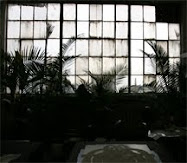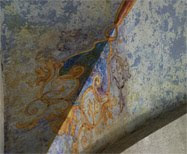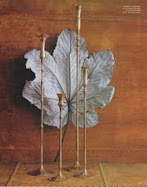My favorite interior designer, John Saladino, recently featured scratch coat plaster walls in the January-February 2010 issue of Veranda magazine. The article, Saladino in SoHo, presented John’s designs, inspired by the Vermeer-based film Girl With a Pearl Earring, for the Veranda NYC show house.
Photography by Antoine Bootz in Veranda magazine
Photography by Antoine Bootz
Photography by Antoine Bootz
Saladino often features walls made with plaster that appear less “finished”. He describes the walls as scratch-coat plaster or brown-coat plaster. What are they?
Back in the days before drywall, the walls in a home were made out of real plaster. The plaster application usually consisted of three steps: the scratch coat, followed by the brown coat and ended with the finish coat.
The first “scratch” coat (also called the intonaco) is embedded onto a wood lath (today metal lath is available which will not warp) and is the base coat. The scratch coat gets its name from the fact that it is physically scratched with horizontal marks. These scratches create the “key” for the next coat to grab onto. The second coat, the brown coat, is applied very thin and creates the flat surface for the finish coat. In Tuscany, this coat is called velo, meaning veil, since it is so thin. The final “finish” coat is a very thin coat that must be kept wet and troweled to a smooth, hard finish. When dry, it will be rock solid and shiny like marble. The finish coat is the thinnest of the coats, and its purpose is to impart a decorative surface to the plaster. The smoother the wall, the more labor involved.
Scratch, brown, and finish coats all have slightly different proportions. Scratch coats are mixed at 1 part cement to 2-1/4 to 4 parts sand, brown coats are mixed at 1 part cement to 3 to 5 parts sand, and finish coats are 1 part cement to 1-1/2 to 3 parts sand.
If you like that look, be sure to check out Saladino’s first book, Style by Saladino. It is full of similar looks. In one, he mixes instant coffee with the plaster and then dried it with the radiator turned on full blast to cause parts of the plaster to dry faster than others, causing the dried colors to vary.
Saladino's wall of scatch-coat plaster using instant coffee with the plaster Photographer: Lizzie Himmel
Scratch coat plaster in John Saladino's book, Style by Saladino
Axel Vervoordt, a fabulous Belgian designer, also favors walls that are more “natural”. Here he mixes lime with powder pigments and earth found locally on the property. Scratch coat plaster walls and these lime and pigment walls are both ancient and modern... and very "green".
From Axel Vervoordt's book, Timeless Interiors
+web.jpg)






























































Hi Ann, although I am not a fan of Axel's craze here in the US, I think that some of his stuff is truly inspiring. His and Saladino's preference for a more "raw" look for the walls is brilliant. Since I first saw the Veranda article I have wanted that wall treatment at my house. It is probably cost effective too, since the full out plastered look will take two more steps. Thanks for letting me knwo about this article. Hugs and kisses,
ReplyDeleteCatherine